Last updated on
Discover innovative chalkboard chore chart ideas because they can transform your daily routine into a well-structured, interactive endeavor.
I’ve designed unique illustrations for these ideas. I hope you get inspired!
Dive into a world where chores become fun by harnessing the creative potential of chalkboard charts.
With the internet sprinkled with many known ideas, it’s easy to feel like you’ve seen it all before. But worry not! This article is set to offer fresh and unique ideas to the chalkboard chore chart repertoire.
While resources to enhance the best of existing ideas will be provided at the end, the prime focus here is to offer new perspectives and exciting angles to reinvent your chore management.
Ready for a rollercoaster of creativity and practicality combined? Let’s get started!
“Before and After School” Chalkboard Chore Chart
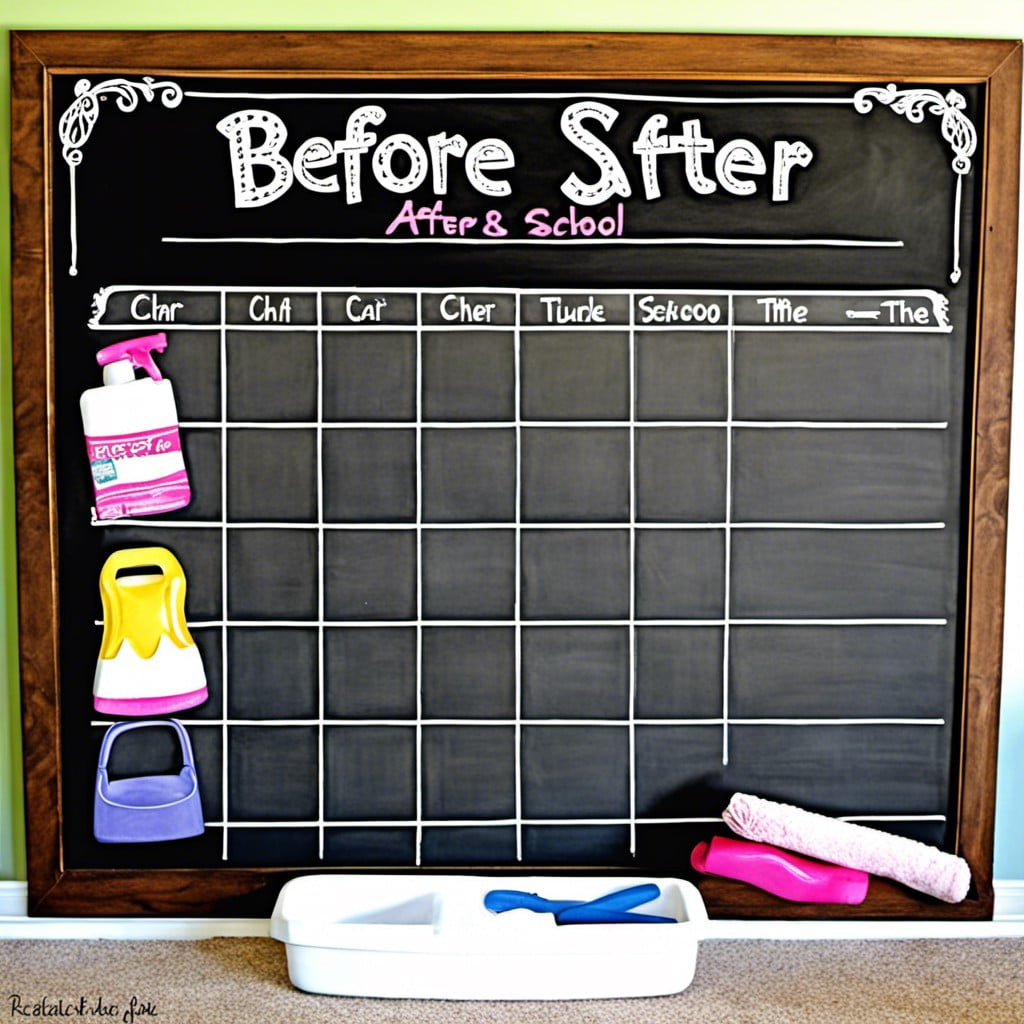
Creating this chart works wonders in keeping your youngster’s busy schedule organized. Start by listing morning and post-school tasks on your chalkboard. Assignments such as packing a school bag, finishing breakfast, doing homework or practicing an instrument.
Use a column design to allocate daily tasks vertically and days of the week horizontally.
- Color-Coding: Add a dash of fun with colors. Assign each task a specific colored chalk, making it exciting and visually engaging for children.
- Personal Touches: Get your kids involved. Let them write their chores and decorate borders around the chart with their creativity.
- Simple Reminder System: An easy prompt to ensure chores are done. Once a task is complete, it can be ticked, erased, or shaded – pick whichever your child loves.
- Reward Section: Incentivize task completion with a reward section. Use a star or sticker system, rewarding them with a treat when they earn a certain count.
Implementing this into your routine helps children understand responsibilities, equips them for a schedule-driven approach, and makes chores something to look forward to.
Weekly Bucket List Chore Chart
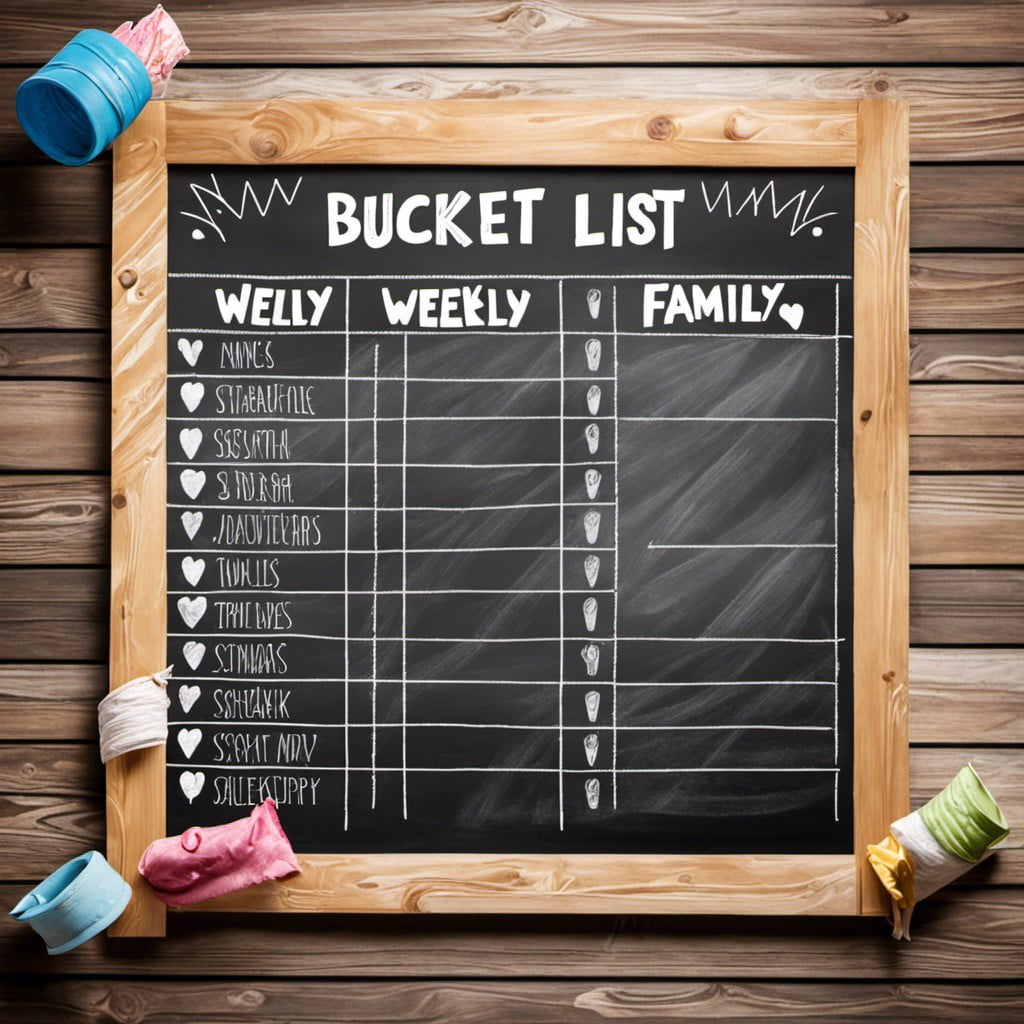
With a Weekly Bucket List Chore Chart, tackling tasks is transformed into a fun, rewarding experience. Designed to encourage a step-by-step approach to chores, this chalkboard chart is divided into days of the week. Each day is then further divided into specific to-dos based on home maintenance and personal responsibilities.
Key points to remember:
- Chalkboard: The basis for your chart, ensures that chores can be easily added, removed, or changed every week.
- Categorization: Daily responsibilities are broken up into bite-sized tasks. This takes major housework and splits it into manageable chores spread over the week.
- Personalization: You can tailor-make this chart to fit your unique household dynamics, with tasks specific to each family member.
- Progress tracking: One look at the chart and you’ll see who has completed their tasks and who has not.
- Reward system: At the end of each successfully completed day or week, rewards can be given as incentives, ensuring that everyone looks forward to chores.
- Activate creativity: Encourage usage of colorful chalks for drawing or highlighting, it can serve as an entertaining way to mark progress.
Remember, a Weekly Bucket List Chore Chart transforms routine housework from a dreary obligation into an exciting, family-friendly activity.
Chalkboard Chore Chart for Pets
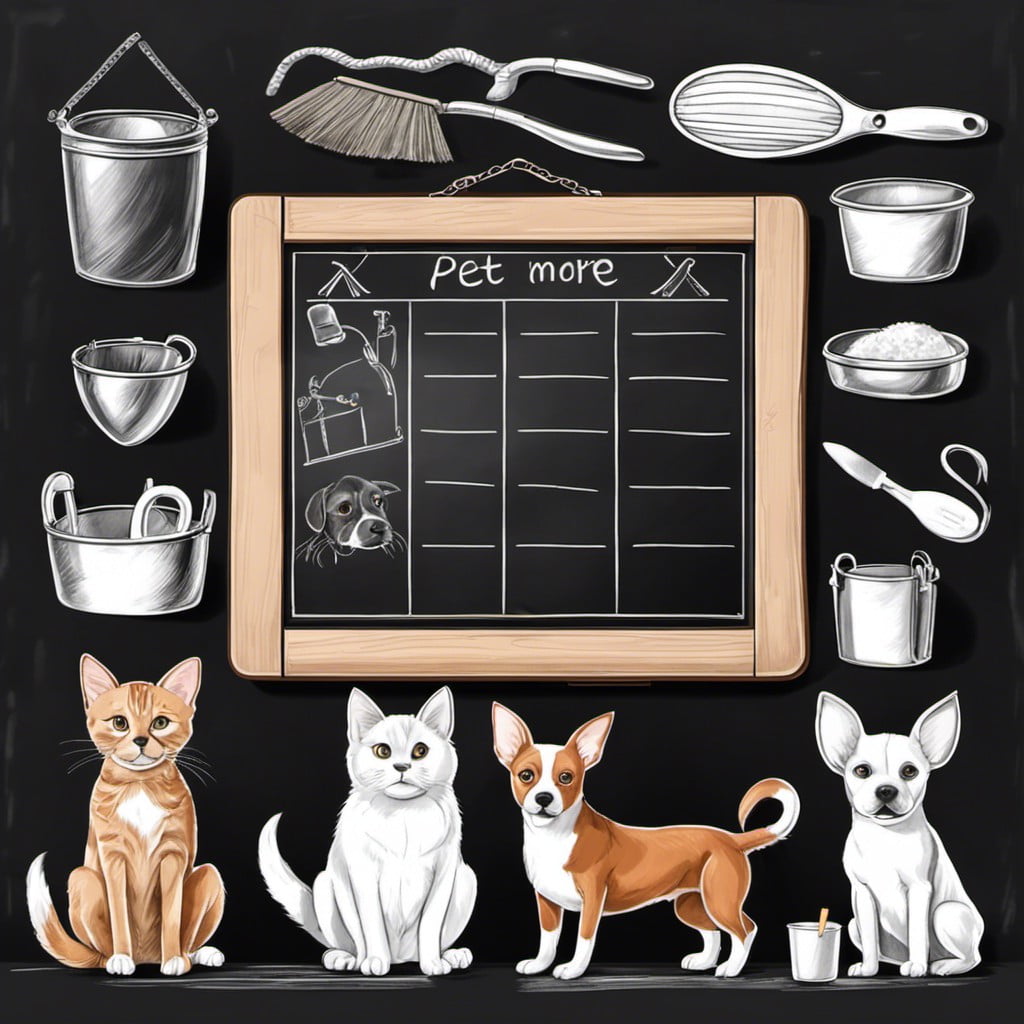
If you’re a pet owner, having a dedicated chart to track your companion’s needs can make your life much easier. Using chalkboard paint on a piece of recycled wood is a fantastic way to accomplish this.
1. List Your Pet’s Daily Needs: Things like feeding times, walks, and medication should be clearly marked.
2. Assign Responsibilities: If there is more than one caregiver in your household, indicate who is in charge of what tasks.
3. Keep Track of Health Check-ups and Vaccinations: This is an important step to ensure your pet’s health is not overlooked.
4. Leave Space for Notes: You may need to leave specific instructions for dealing with dietary requirements or behavior issues.
Such a chore chart not only serves as a fun interactive tool but also aids in maintaining a healthy routine for your precious pe(s). Regular use can also teach children responsibility and time management.
Sports-Themed Chalkboard Chore Chart
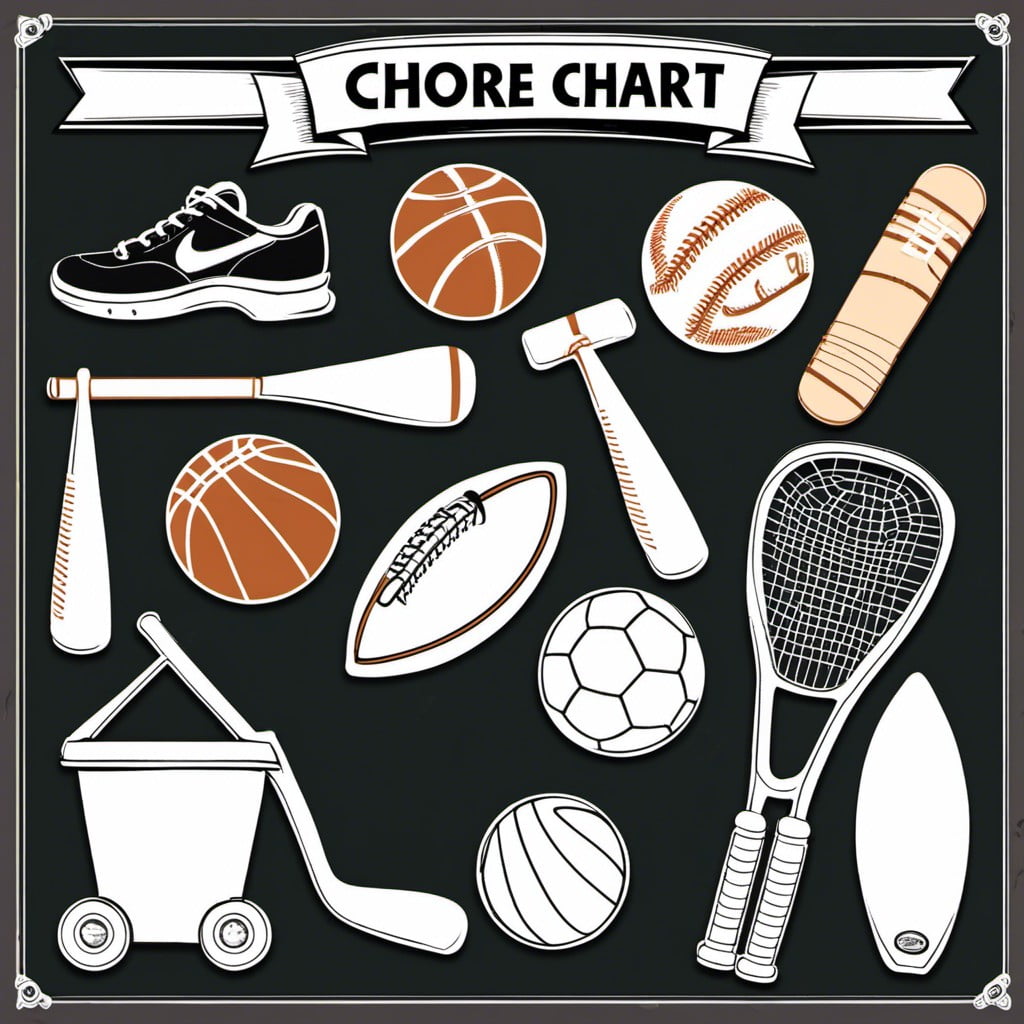
The appeal of the Sports-Themed Chore Chart lies in its ability to excite sports enthusiasts. The chart can be crafted to resemble a basketball court, soccer field, or baseball diamond, depending on the preferred sport.
1. On each chart, chores could be listed in the spaces typical to player positions. For example, in a football-themed chart, ‘cleaning the room’ might be put in the goalkeeper’s position.
2. Score points can be assigned to each chore completed. The tougher the chore, the higher the score.
3. The chalk is suitable for marking game plans, which in this case are chores, and tallying scores that correspond to completed tasks.
4. Teamwork and competitiveness can be integrated by assigning teams, making chore completion a fun and engaging game.
5. Customizing jerseys or player figures with tasks encourages kids to get more involved, and the chalkboard format allows for easy updating of the chore list if needed.
6. For an added twist, you can introduce ‘penalties’ for chores not completed.
This design not only makes it easy to keep track of chores but also adds an element of fun to mundane tasks.
Chore Reward System Chart
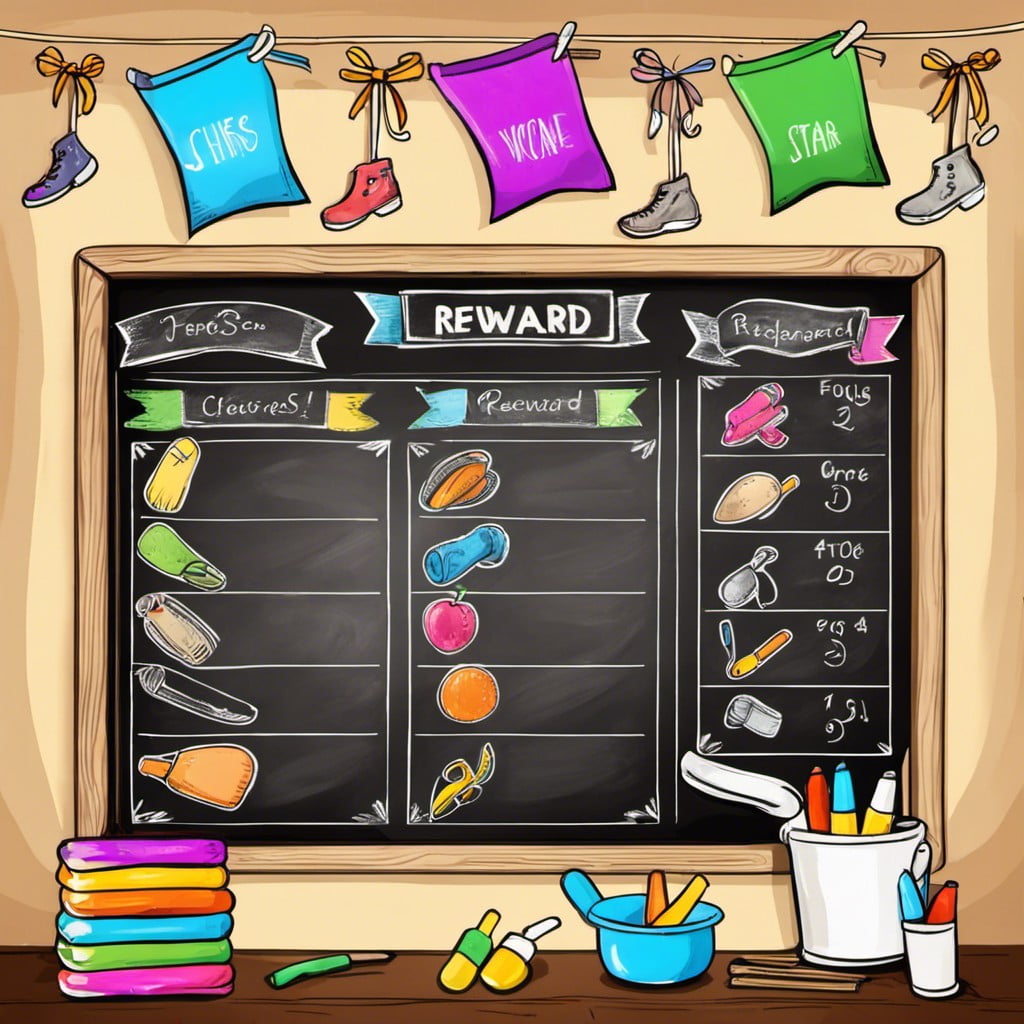
Moving on to this handy approach, the premise is simple yet effective. A Chore Reward System Chart involves assigning each task a particular reward or point value. This approach, often a hit with children, encourages accountability. It’s more like a barter system – tidy up your room and earn 5 points, clear the dishes and add 3 more.
Here’s how it usually works:
- Establish a list of chores—this can range from simple tasks like making the bed to more complex ones like helping with grocery shopping.
- Assign points or rewards to each chore. The more difficult or time-consuming the task, the higher the reward.
- Keep a tab of earned rewards after chores are completed. Make sure this tallying process is visible and easily understood.
- Set up a reward system. This could be in the form of privileges like extra TV time, a favorite meal, or accumulating points to ‘purchase’ a desired toy or outing.
Remember, the key is making chores engaging and the outcomes gratifying, which this chart brilliantly incorporates. Stick with consistency in rewarding and soon, chores may not feel like work at all. Regularly revise chores and rewards to maintain interest and account for growing abilities.
Chalkboard Chore Chart With Photos
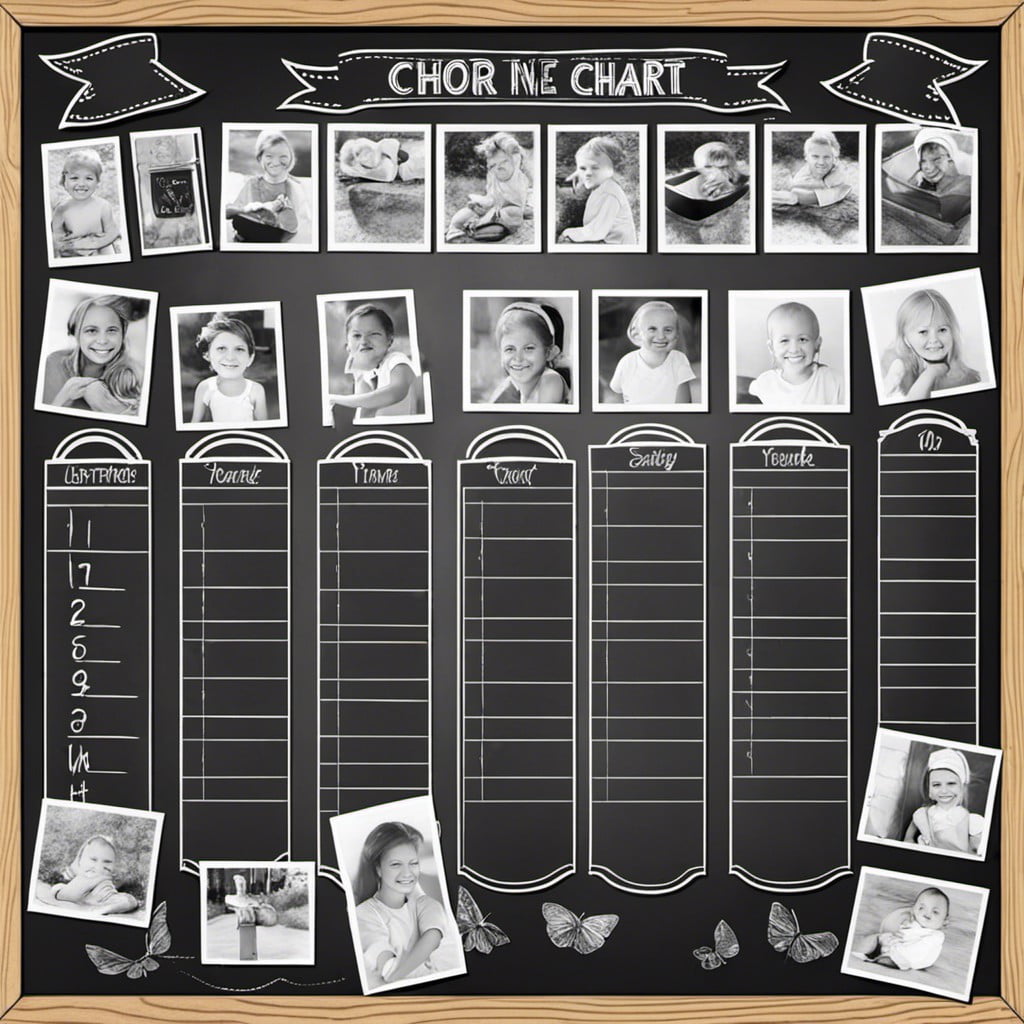
Personalize your chalkboard chore chart by adding photos next to each task. This gives a unique visual cue, especially helpful for young children who can’t read yet.
For this, you’ll need some square photos of your family or kids, a chalkboard and chalk, a fine-tip chalk marker, and magnetic photo frames.
Begin by designing your chart layout with a chalk marker: list chores down the side and days of the week across the top.
Then, place photos next to each chore, assigning a task to each family member.
Since the frames are magnetic, it’s easy to swap out photos as needed.
This creative project not only organizes household duties but also adds a fun, personalized touch to your home decor.
Baking Sheet Turned Chore Chart
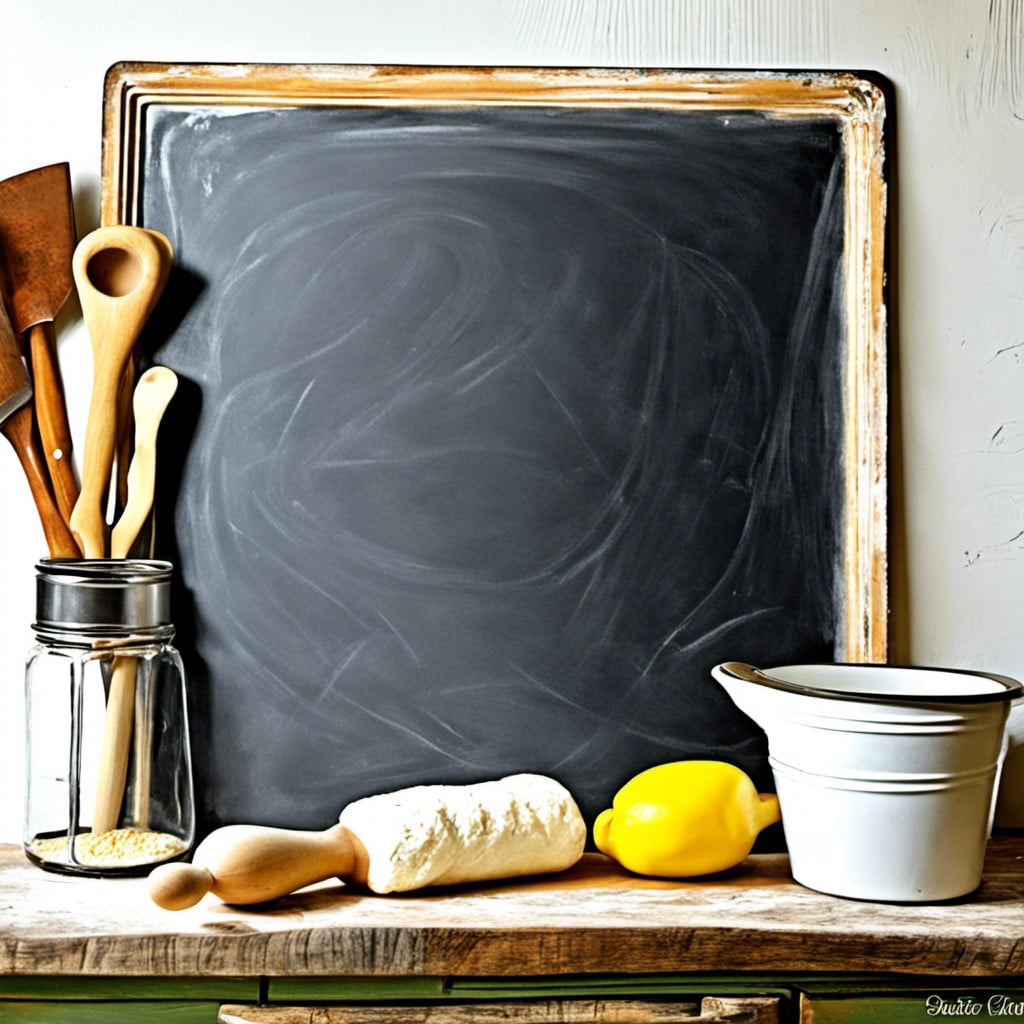
Perfect for those seeking a unique and innovative approach, the baking sheet chore chart requires just a few supplies. Start with an old or unused baking sheet. A coat of chalkboard paint transforms it into a reusable, magnetic board. The flat surface provides ample space for listing chores, each marked with a corresponding magnet.
1. Supply List: A baking sheet, chalkboard paint, a paintbrush, and small magnets.
2. Prep the Sheet: Clean the sheet thoroughly and sand any rust spots before applying the chalkboard paint.
3. Painting: Apply two to three even coats of chalkboard paint, allowing sufficient drying time between each.
4. Tasks & Magnets: Once dry, list chores and assign a magnet to each task to be moved as chores transition from “To-Do” to “Done”.
5. Customization: Add a spot for each child’s name, or even sections for daily and weekly chores.
This functional, yet aesthetic chart not only streamlines your household but also brings a touch of creativity and playfulness to chore management.
Separate Chalkboard Chore Charts for Multiple Kids

Equipping each child with their own individual chalkboard allows an easy-to-customize layout, especially where daily and weekly chores differ between the little ones. It fosters a sense of responsibility and accountability in managing their tasks.
Additionally, it adds a personal touch as each board, set in strategic places such as bedroom doors, can be designed according to each child’s preference. The method also minimizes instances of comparing and bickering over tasks – everyone knows exactly what they need to do.
Children can enjoy checking off their finished chores, creating a sense of accomplishment, while erasability provides an eco-friendly way to ensure these boards will last for years.
Interactive Puzzle Chore Chart
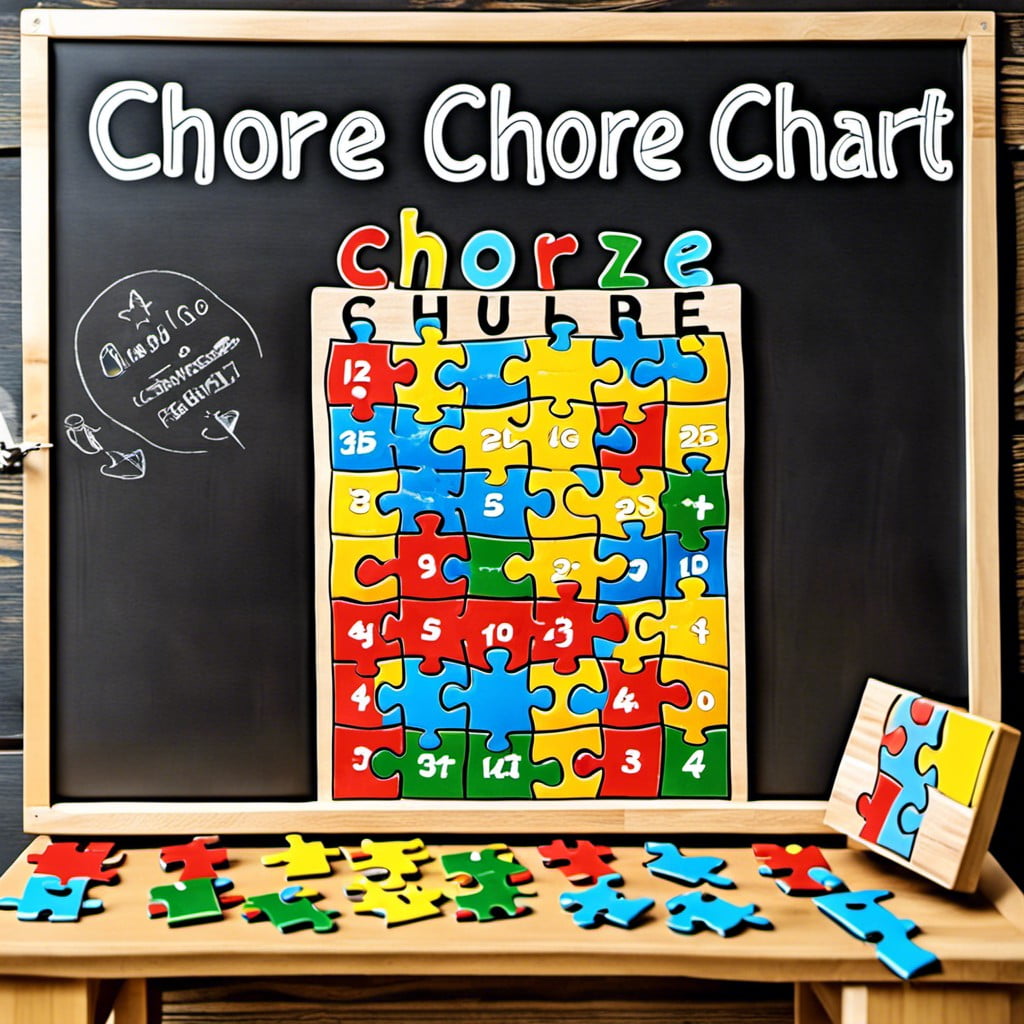
Crafted from a simple chalkboard, this chart turns daily tasks into an exciting game, a puzzle to be solved.
Here’s how it works:
- 1. Design different puzzle pieces for each chore. These can be as simple or as intricate as you prefer.
- 2. Write the specific chore on each puzzle piece. This means every time a task is completed, the relevant puzzle piece can be added onto the chalkboard.
- 3. The goal is to complete the puzzle by the end of the day, week, or any set period. This means all chores must be finished to get the satisfaction of a completed puzzle.
The Interactive Puzzle Chore Chart not only organizes chores but also incentivizes children with a visually rewarding puzzle to complete. It merges fun and responsibility in a creative way.
Chalkboard Chore Bunting
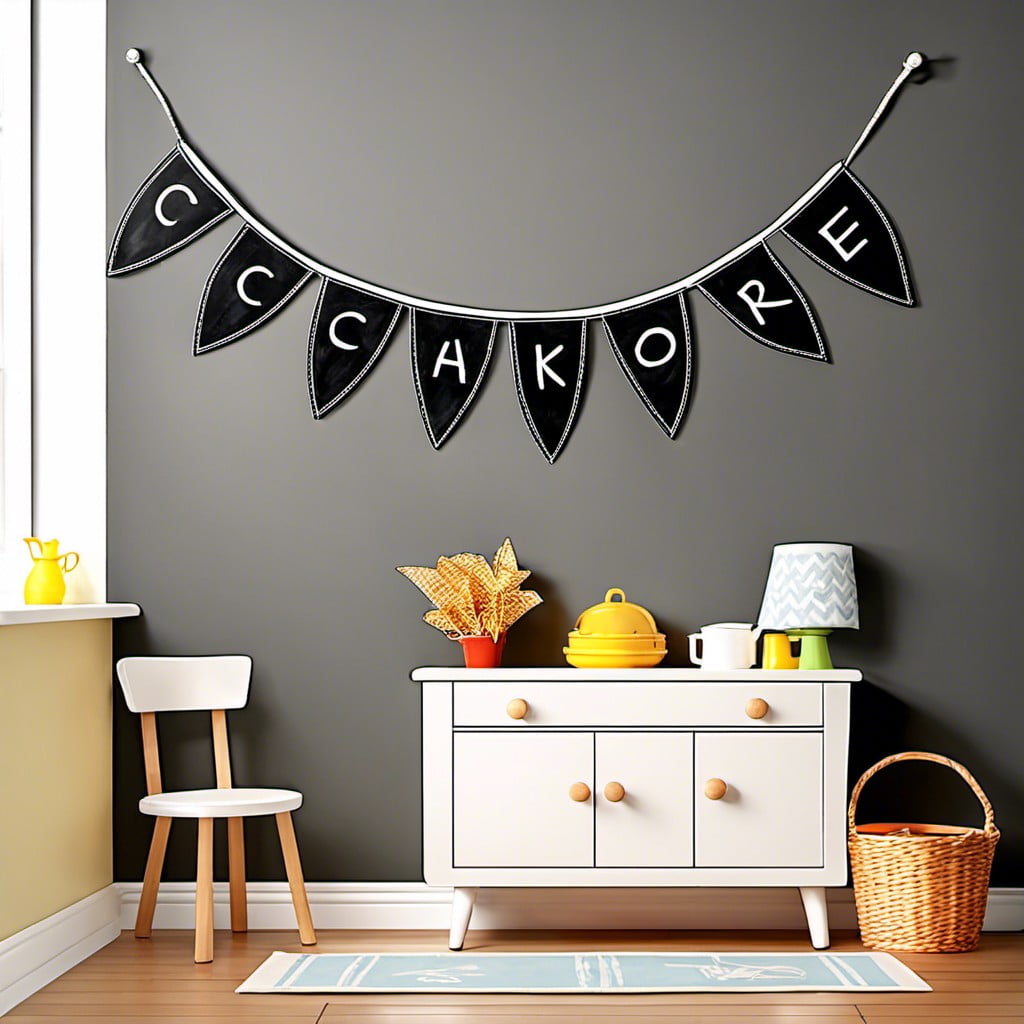
The magic of chalkboard chore bunting lies in its flexibility and fresh aesthetics. As an out-of-the-box idea, it adds a comfortable fusion of creativity and functionality. The beauty of this option is that it can be color-coordinated for each family member and can change shape or title as chore assignments shift.
Here are a few points defining Chalkboard Chore Bunting:
- Optimal Flexibility: Chores can be added, removed, or swapped with ease. Simply erase the previous chore and write the new one.
- Personalization: Each bunting can be customized for individual family members. Use different colors or decorating styles for clear differentiation.
- Versatile Display: Whether hung on a wall or draped over a door, buntings can adapt to any space making visibility easy.
- DIY Friendly: It’s an easy homemade craft. A few pieces of black cardstock, some chalk markers, and string are all you need to get started.
Remember, the ultimate goal is to make household duties something to look forward to, and a Chalkboard Chore Bunting certainly does the trick!
DIY Erasable Chalkboard Chore Chart
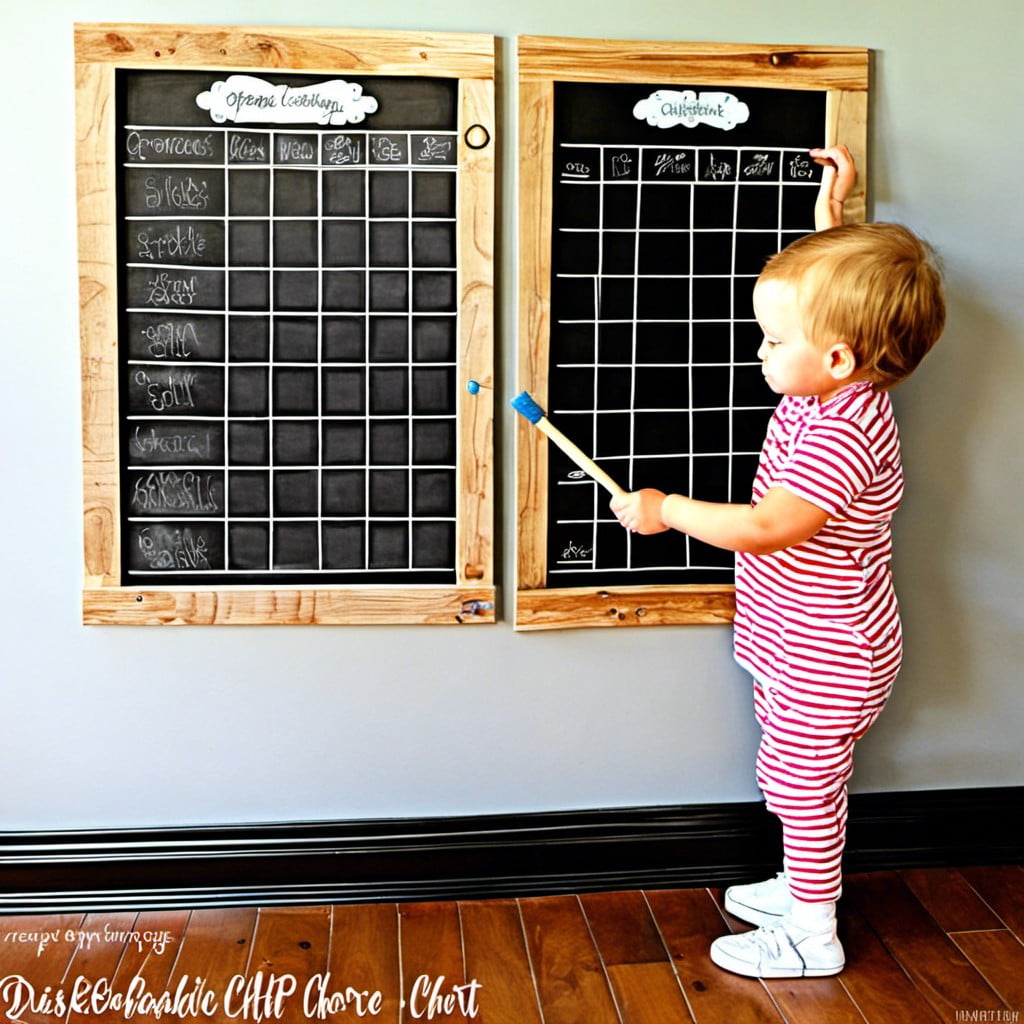
The beauty of this chart lies in its reusability. You can easily create one using a picture frame and chalkboard paint. Once the paint is dry, fill in the chart with chalk or a chalk pen.
The chores, which you can list down the side, might include tasks like ‘clean the dishes’, ‘take out the garbage’, or ‘do the laundry’.
Along the top, write the days of the week.
To assign chores, mark each row with an ‘X’ under the corresponding day. When a chore is completed, the individual responsible can erase the ‘X’.
This gives a visual guide to the tasks completed and those still pending, fostering accountability and responsibility.
Remember, the key to the DIY erasable chalkboard chore chart is consistency. Ensure everyone checks and updates it regularly!
Chalkboard Chore Chart for Roommates
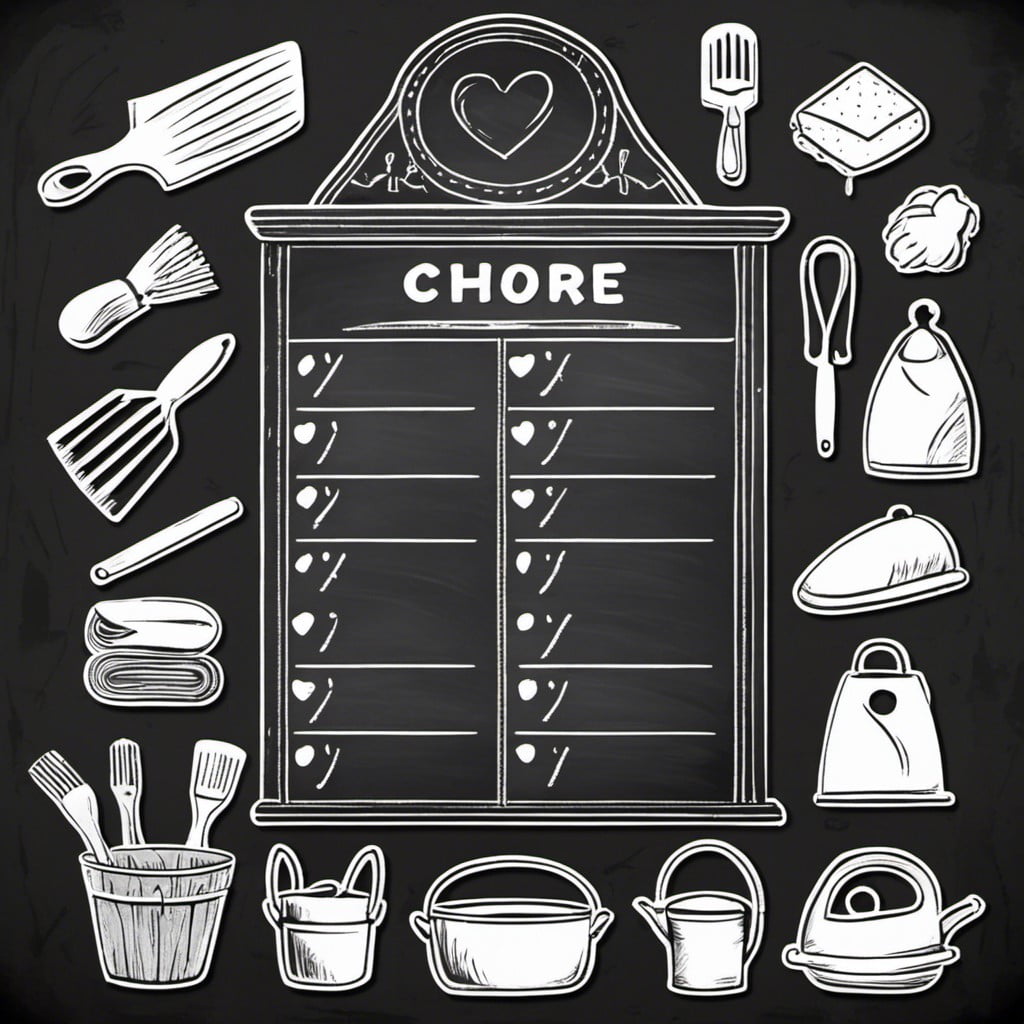
Living with roommates can sometimes be a challenge, especially when it comes to sharing chores. However, navigating daily tasks can become more manageable with the help of a chalkboard chore chart.
This chart serves as a clear, easily-updated system for everyone to keep track of their responsibilities. It can be divided by days of the week, person, or chore type, depending on your unique living situation. A color-coding system is also a smart addition, assigning a specific hue to each individual, making it easier to discern at a glance.
If you prefer creativity, you can include doodles or calligraphy to the chart, adding a bit of personality and fun to the task division. For a digital twist, photos of each roommate next to their duties can add more personalization and flair.
Remember, the goal is to create a straightforward, visually appealing chart that increases household harmony and productivity.
Inspirational Quotes Chalkboard Chore Chart
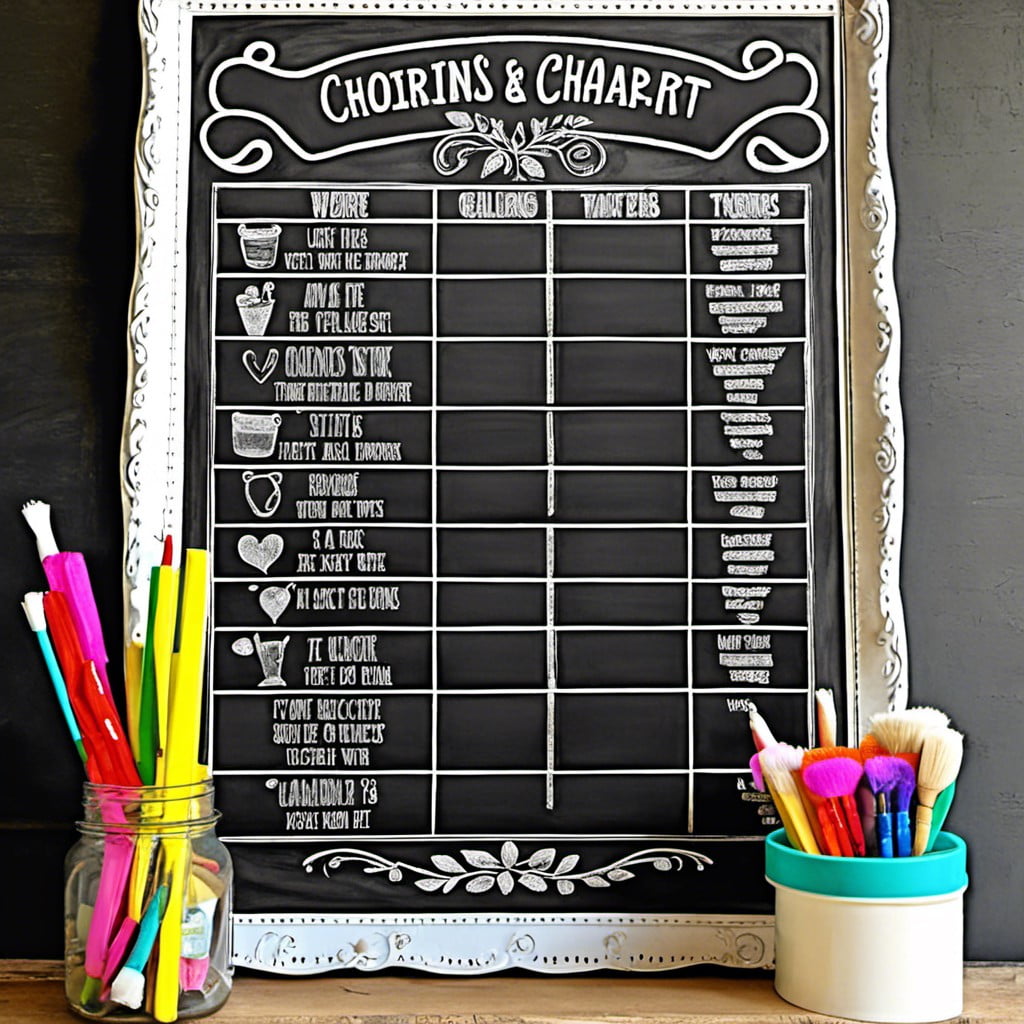
Creating this chart begins with writing a memorable quote or motto at the top of your chalkboard. Then, a list of chores is assigned to each family member underneath. When a job is complete, they can check it off.
A few salient points are:
- 1. Use bright chalk colors to keep things lively and engaging.
- 2. Select quotes related to productivity or teamwork for added motivation.
- 3. Adjust chores and quotes weekly to keep them fresh and relevant.
- 4. Let family members take turns choosing the quote for the week.
- 5. Have a special surprise or reward for those who complete all their chores for an added incentive.
- 6. Incorporate an artistic element by beautifully scribing the quote at the top.
- 7. Multicolored lines can be drawn to clearly separate each family member’s tasks and to prevent any possible confusion.
- 8. Always remember, the shared responsibility and combined effort should be the focus, fostering a sense of unity and work ethic.
Remember, the goal is to encourage responsibility and teamwork in a fun and inspiring way.
Seasonal Chalkboard Chore Chart
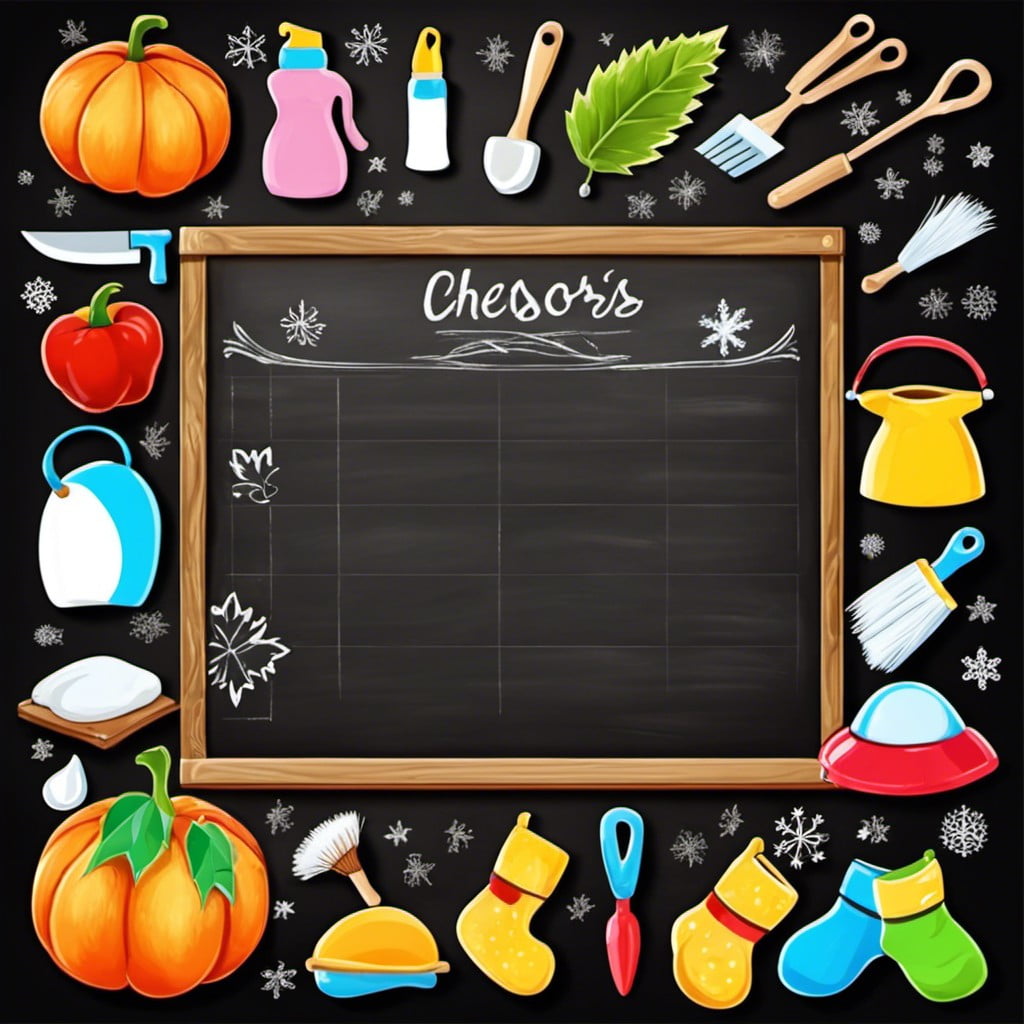
Focusing on the seasons, this chart provides a refreshing change four times a year. In winter, it could include chores like shoveling snow or holiday decoration duties. Spring might bring planting flowers or cleaning responsibilities with it.
Add in lawn mowing or pool tasks for summer, while fall could highlight raking leaves or preparing for school. A major plus is the potential for incorporating learning about the changing seasons while teaching responsibility.
You may enrich the experience by decorating the chart with season-appropriate illustrations, creating an exciting and engaging chore routine. Make sure you include spaces for assigning chores to family members and a reward section to motivate everyone.
Family Tree Chalkboard Chore Chart
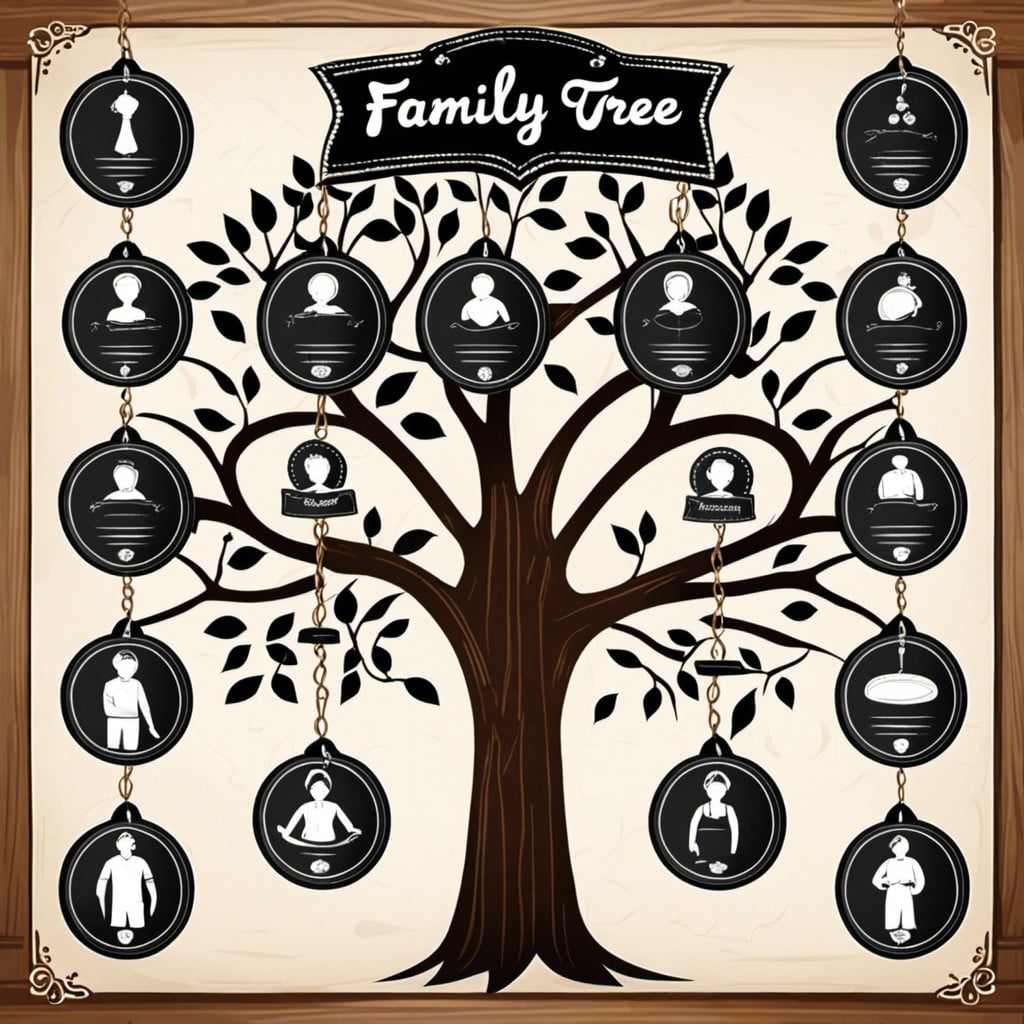
Incorporating a family tree into your chalkboard chore chart brings an element of fun and personalization. A unique and engaging way to distribute tasks, it showcases everyone’s part in maintaining the household.
1. Basic Structure: Start by sketching a family tree on your chalkboard. Include everyone, even pets!
2. Allocate Chores: Assign a task to each family member, written near their name.
3. Add Creativity: Make the tree colorful and engaging. Use symbols to represent chores – a broom for sweeping, a dish for washing up.
4. Encourage Responsibility: As chores are completed, the person responsible can tick their task off, helping children to feel accomplished.
5. Update Regularly: Keep it exciting by shuffling chores or including unique tasks to coincide with national holidays or family events.
This idea helps to foster a sense of responsibility and community within your family while making the often mundane task of chore allocation playful and enjoyable.
Travel-Themed Chalkboard Chore Chart

One exciting take on chore charts is to focus on a travel theme. It’s an excellent approach for instilling in children a sense of adventure, along with responsibility.
Here are some insightful points on creating a travel-themed chalkboard chore chart:
- 1. Using a black or green chalkboard paint, create a world or a specific country’s map as the base of the chart.
- 2. Area-wise allotment: Each country or state can represent a different chore.
- 3. Use colorful chalks: Different colored chalks can represent completed chores, in-progress, or those yet to be done.
- 4. ‘Destination’ rewards: Give the chart an exciting twist with rewards being popular places they want to explore.
Apply these concepts to a chalkboard chore chart, and you’ll have a fun, interactive tool that not only helps keep track of duties but also sparks interest in geography and travel.
Customized Chalkboard Chore Chart With Your Kids’ Drawings
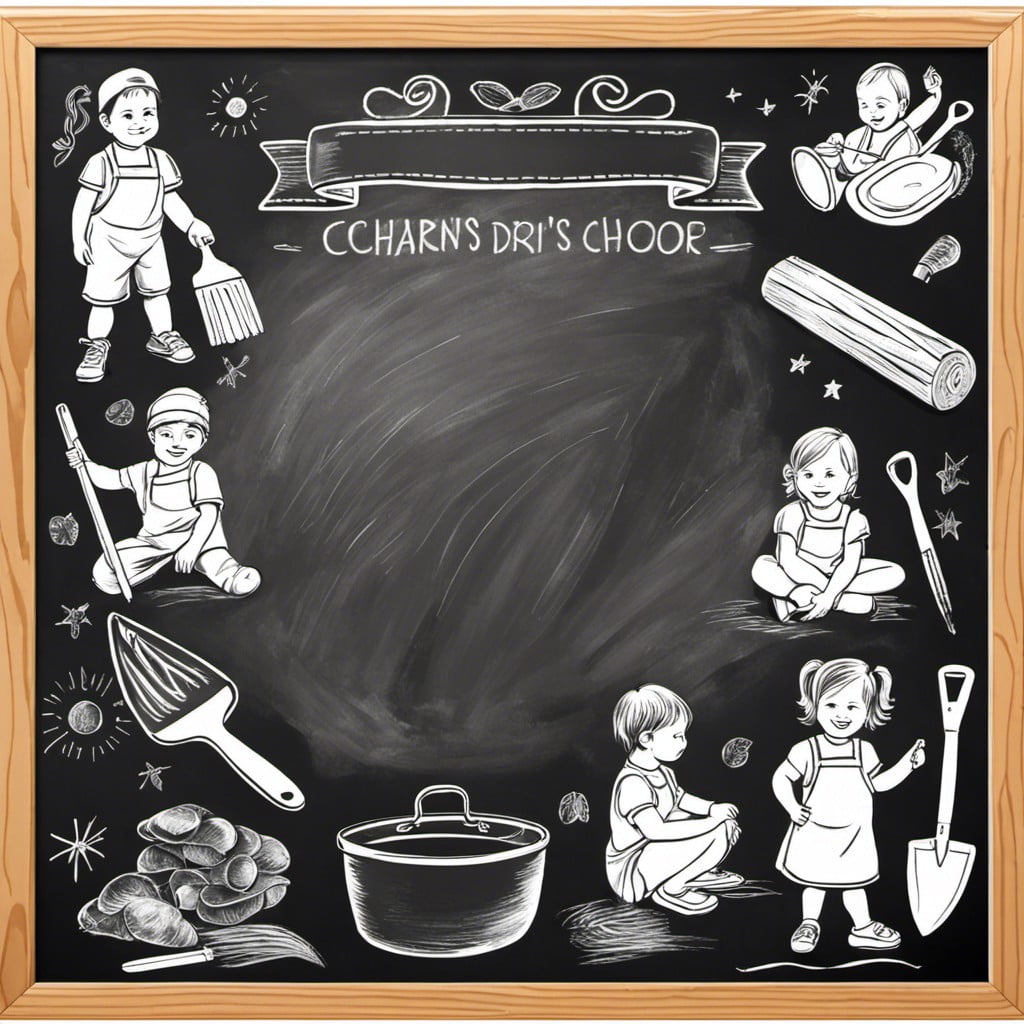
In this masterstroke, the charts are personalized with children’s artwork, making them more appealing and engaging. Here’s your guide:
1. Choose a chalkboard: Opt for a size that fits your space and demands. A small one is apt for daily chores; a larger one works for monthly tasks.
2. Draw the outline: Use a ruler to draw a chart with the chores vertically, and the days of the week horizontally.
3. Add the fun: Encourage each child to draw small pictures next to their chores, providing a visual cue.
4. Incorporate a color code: Assign different chalk colors to your children. This makes it easy for them to recognize their chores at a glance.
5. Update regularly: Ensure the chores stay rotating to keep things fair and interesting.
This interactive board is an effective way to include art and responsibility into your children’s routines while making chore time something they actually look forward to!
Retro Diner Menu-inspired Chore Chart
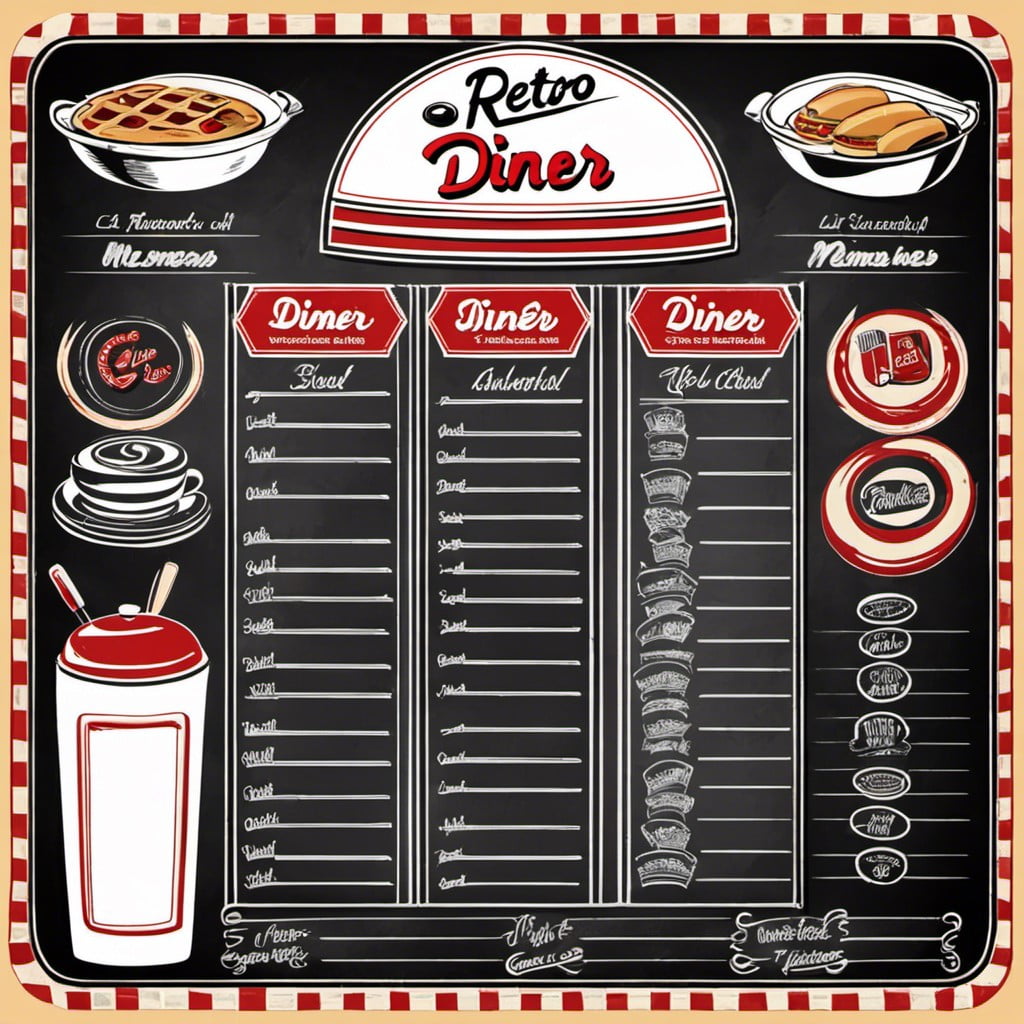
Drawing from the aesthetic of a 1950s diner, this unique approach incorporates a bit of nostalgic charm into your daily routine. Adorn the blackboard with markered retro typefaces and categories typical of a classic menu: start with ‘Appetisers‘ for morning chores, follow with ‘Main Course‘ for bigger tasks in the afternoon, and conclude with ‘Dessert‘ for evening duties.
The visual features can be amplified with neon-colored chalk or markers, reinforcing the vintage feel. For the kids, this whimsical interpretation of tasks can make chores seem more like a fun activity than an obligation. Add small sketches or doodles next to each chore to enhance readability and engagement.
This style of chart also leaves room for creativity. For example, ‘Chef’s Specials‘ section can be used for a rotating weekly chore or an exceptional one-off task. Additionally, integrate a ‘Diner Ratings‘ section to encourage feedback—stars can be filled in once chores are completed promptly and correctly. Though simple to set up, this method keeps the tasks organized in a fun, visually attractive way without making workflow overwhelming.
Remember, the goal is not only to foster responsibility but also to do it in a manner that’s engaging and enjoyable.
Outer Space Chalkboard Chore Chart
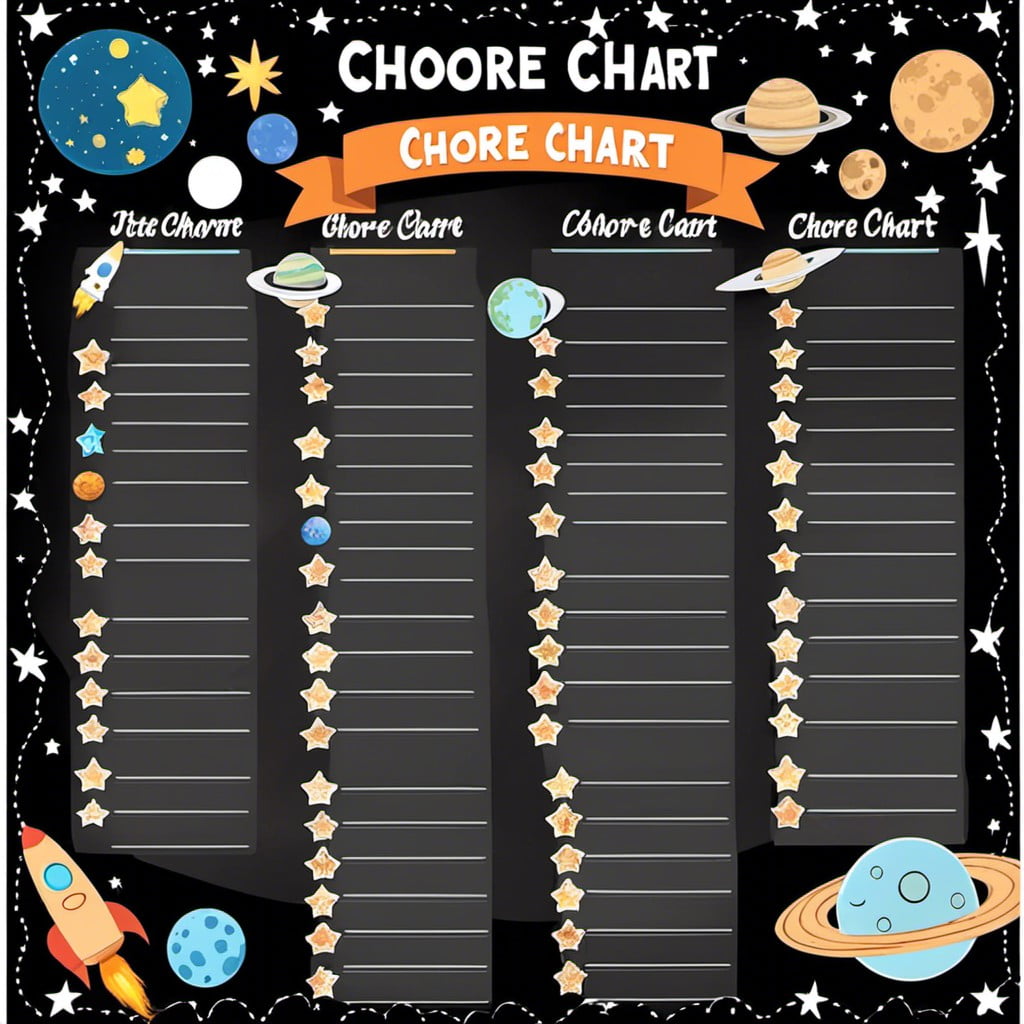
Sitting at number 19 on our list, it’s time to embark on an interstellar cleaning mission. This variation is both fun and educational, integrating cosmic concepts into daily tasks.
Here’s how to create this engaging setup:
- Label tasks with space-themed terms— “Rocket Repair” could mean fix a broken toy, or “Alien Infiltration” could translate to dusting under the bed. Enhance the playfulness and keep children intrigued.
- Use different celestial bodies as markers for different tasks. Satellites for weekly tasks, planets for daily ones, and stars for surprise chores.
- Utilize galaxy-colored chalk for writing and drawing. It’ll visually reinforce the theme and keep the chart vibrant and lively.
- Incorporate the chores with lessons about the solar system. For instance, you might assign a week to each planet, where the child can learn fun facts as they cross off their list.
Remember, the aim is to engage children in their chores while fostering a love for space exploration!
Garden-Themed Chalkboard Chore Chart
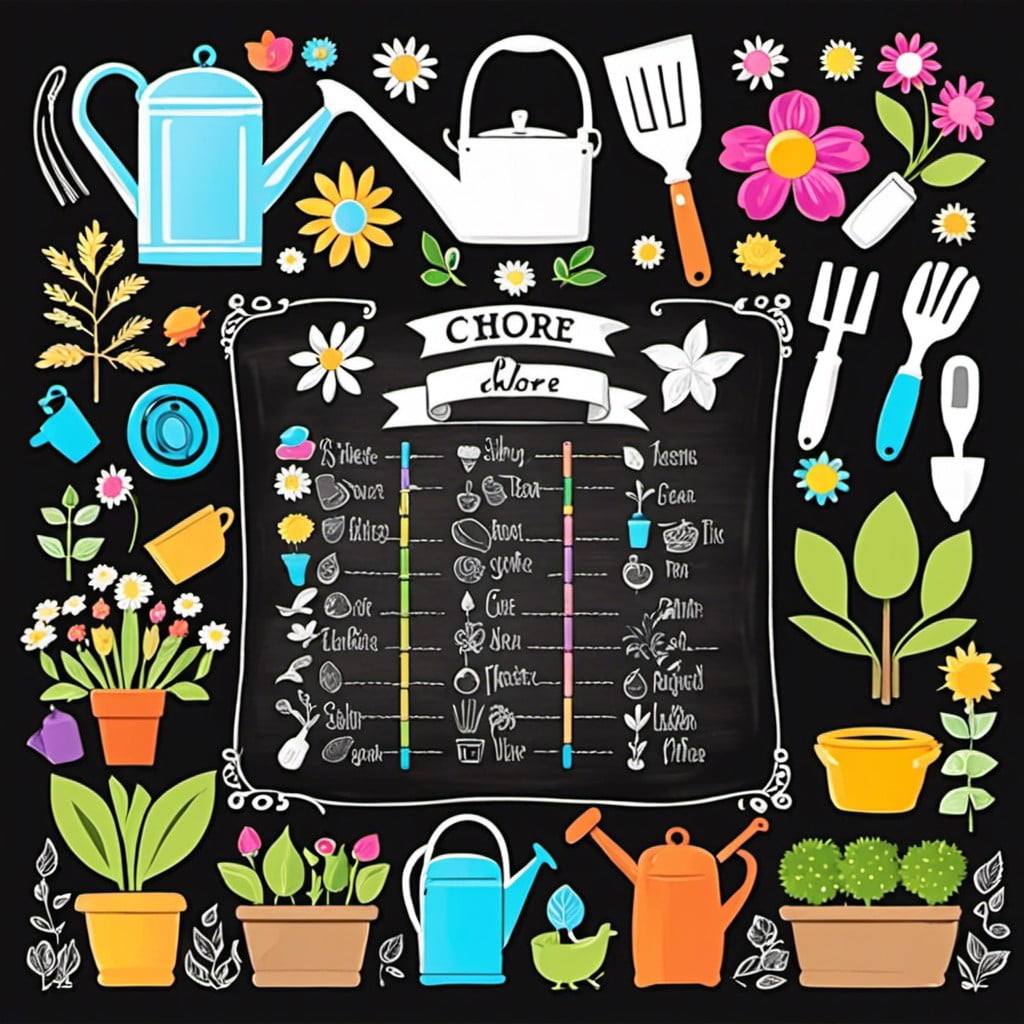
Capitalizing on nature’s beauty, this chart breathes refreshing vibes into the chore routine. Start by sketching a simple trellis or leafy vine design along the edges, serving both as decoration and section dividers.
Each individual’s name can nestle within a leaf or flower and their respective tasks inscribed beside. For younger kids, use images to depict tasks like a watering can for watering plants, or a basket for laundry.
Painting tasks as gardening aspects, such as ‘pruning’ for trimming nails, or ‘sowing’ for homework, could make chores seem fun. Change the chores with the seasons to keep things interesting – sow in spring (study), bask in summer (free time), harvest in autumn (clean room), and winter pruning (personal grooming).
Remember to keep the chore list manageable. Reward progression with leafy ‘grown’ stickers and celebrate the blooming family garden. The chart is not only appealing but also fosters a sense of responsibility and the importance of nurturing – both self and surroundings.
Ideas Elsewhere
- https://www.sunnydayfamily.com/2019/04/money-for-chores-chart.html
- https://www.simpleshapes.com/products/chores-chart-chalkboard-wall-decal
- https://www.womansday.com/home/crafts-projects/g2597/chore-charts-for-kids/
- https://2beesinapod.com/chalkboard-chore-chart/
Recap:




